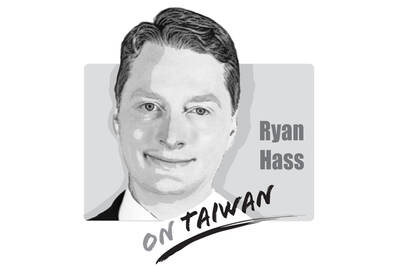The Constitutional Court on Friday last week ruled on the constitutionality of the death penalty. Although its ruling makes sense, many opposed the court deciding this case.
As an academic who teaches introductory coursework on criminal procedure law, I am not personally satisfied with the ruling. However, the result is still acceptable.
Compared with the laws of other advanced democracies, the Code of Criminal Procedure (刑事訴訟法) is behind the times. The implementation of criminal hearings is inconsistent with the stipulations of the code. Even to this day, Taiwan is implementing indirect and written case hearings — a process dating back to the Qing Dynasty.
For a deeper understanding, read the essay “The Relationship Between Constitutional Law and the Code of Criminal Procedure” (憲法與刑事訴訟法之關係) in The Code of Criminal Procedure Review, Volume 3, extended edition (刑事訴訟法研究、第三冊、增訂版).
During the latter half of the 1700s, the UK, the US, France, Germany and other Western countries implemented similar laws to that of the Qing Dynasty. All of them used indirect or written hearings in criminal cases.
Despite following several hundred years of judicial experience, these indirect and written hearings were found to have produced many mistrials and misrulings. By the end of the 1700s, and with the rising adoption of more democratic concepts, direct and oral hearings were adopted to reduce the frequency of mistrials.
The most effective of the direct and oral hearings is the jury trial system. However, even with the adoption of such a system, mistrials and misrulings could not be completely avoided. To avoid mistrials and the conviction of innocent people, a legal motto and ethos of being willing to let 10 guilty people go free rather than convict one innocent person came into being.
That being the case, Taiwan’s criminal trials are still operating by the logic of the Qing Dynasty’s indirect and written hearing procedures. Taiwan’s criminal court judges and prosecutors maintain the ideology of the White Terror-era court system operating under martial law.
In contrast with the aforementioned legal motto, there is an underlying concept in Taiwan’s judicial system that it would rather convict 10 innocent people than set one guilty person free.
Consequently, there has been no lack of mistrials involving the conviction of innocent people.
After a wrongful conviction resulting in the death penalty, nothing can be done to remedy the situation after the sentence has been carried out. From that point of view, the Constitutional Court’s ruling in this matter must ultimately be accepted. Hopefully, wise opponents of the death penalty can understand this position.
The abolishment or upholding of the death penalty is predicated on the good nature of Taiwanese. For this issue, the legislature should be the real arbiters of the death penalty’s constitutionality — not the courts.
Simultaneously, the Constitutional Court is at its core a specialized court — a “court” in the narrow sense of the word, also referred to as a “tribunal.” This special tribunal is a product of an authoritarian system. Such a specialized judicial body should not exist in a democracy.
If Supreme Court judges still do not have a grasp of the profundities of constitutional law, they should not be sitting on the nation’s highest court.
The Constitutional Court should be abolished, and its role taken up by the Supreme Court, with judges qualified for that position. This is the correct way forward.
Huan Tong-shong is a former president of National Chung Hsing University.
Translated by Tim Smith
When US budget carrier Southwest Airlines last week announced a new partnership with China Airlines, Southwest’s social media were filled with comments from travelers excited by the new opportunity to visit China. Of course, China Airlines is not based in China, but in Taiwan, and the new partnership connects Taiwan Taoyuan International Airport with 30 cities across the US. At a time when China is increasing efforts on all fronts to falsely label Taiwan as “China” in all arenas, Taiwan does itself no favors by having its flagship carrier named China Airlines. The Ministry of Foreign Affairs is eager to jump at
The muting of the line “I’m from Taiwan” (我台灣來欸), sung in Hoklo (commonly known as Taiwanese), during a performance at the closing ceremony of the World Masters Games in New Taipei City on May 31 has sparked a public outcry. The lyric from the well-known song All Eyes on Me (世界都看見) — originally written and performed by Taiwanese hip-hop group Nine One One (玖壹壹) — was muted twice, while the subtitles on the screen showed an alternate line, “we come here together” (阮作伙來欸), which was not sung. The song, performed at the ceremony by a cheerleading group, was the theme

Secretary of State Marco Rubio raised eyebrows recently when he declared the era of American unipolarity over. He described America’s unrivaled dominance of the international system as an anomaly that was created by the collapse of the Soviet Union at the end of the Cold War. Now, he observed, the United States was returning to a more multipolar world where there are great powers in different parts of the planet. He pointed to China and Russia, as well as “rogue states like Iran and North Korea” as examples of countries the United States must contend with. This all begs the question:

Liberals have wasted no time in pointing to Karol Nawrocki’s lack of qualifications for his new job as president of Poland. He has never previously held political office. He won by the narrowest of margins, with 50.9 percent of the vote. However, Nawrocki possesses the one qualification that many national populists value above all other: a taste for physical strength laced with violence. Nawrocki is a former boxer who still likes to go a few rounds. He is also such an enthusiastic soccer supporter that he reportedly got the logos of his two favorite teams — Chelsea and Lechia Gdansk —